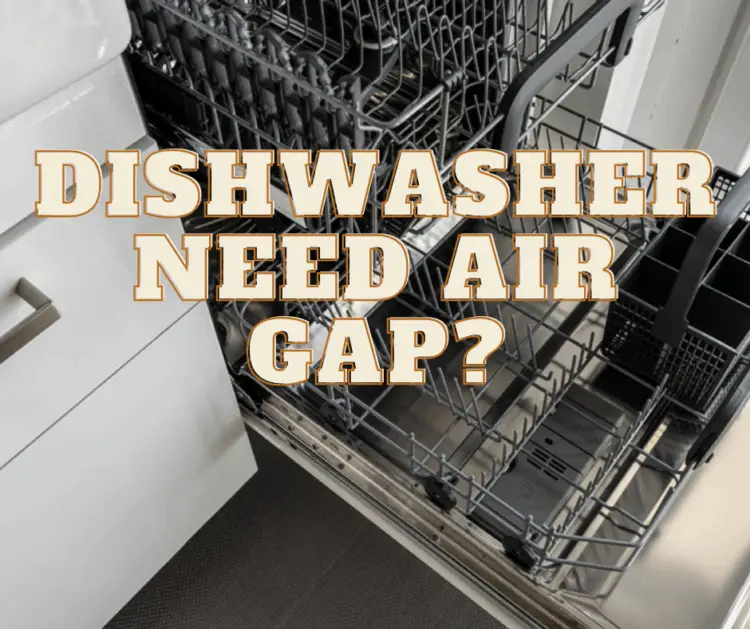Air gaps on a dishwasher serve a clear purpose in its drainage system. Every dishwasher should therefore have this crucial component – and so should yours. In most states, air gaps are code, and every dishwasher plumbing must include one to facilitate seamless drainage.
An air gap prevents wastewater cross-contamination on any dishwasher’s clean water supply. It provides an unpressurized gap with a hydraulic impact to prevent wastewater from siphoning back through the drain pipe. Air gaps are standard plumbing codes countrywide, and your dishwasher should have one.
Since dishwasher drainage systems are susceptible to clogging from grime and food particles, wastewater can cause backflow and de-purify clean water supplies in your dishwasher. Although air gaps are a better solution, there still are other ways to solve this problem, although not as effective. This guide will provide insight into installing an air gap, how to tell if it’s clogged, and enumerate further on these essential components.
How a dishwasher air gap works
The principle behind the working of dishwasher air gaps is pure physics. Ideally, water flowing through pipes uses hydraulic pressure to force its way forward. With this standard principle, dishwasher air gaps proficiently prevent backflows by intercepting the water’s hydraulic pressure. When garbage disposals clog, it bars water from draining, inducing undesired backflows that cross-contaminate clean water in your dishwasher.
Technically, air gaps completely separate the hoses draining water from the dishwasher from those that trickle the wastewater into the drainage. With an air opening in the middle, water pours from one hose’s opening and flows down into the other. The draining section of the pipe sometimes passes through a garbage disposal, but it’s not always the case. Some sinks lack garbage disposal but work just fine.
Plumbers place air gaps a few inches above a dishwasher’s wastewater outlets to achieve this hydraulic impact. This installation technique is similar to other air gap alternatives, including high loops and dishwasher standpipes. Plumbers usually fix air gaps on sinks’ countertops and cover them with metal shells protruding as elongated knobs. It’s also typically to disguise air gaps by integrating them within the tap faucet, which offers a creative solution for space. The motive of placing them on countertops is to achieve the hydraulic impact of the air space the air gap creates. Besides, water can safely flow into sinks rather than splash all over your kitchen in case of overspills.
How to tell if an air gap is clogged and ways to unclog it
If your air gap clogs, it hampers drainage from your dishwasher, which floods with water. It’s particularly gross for wastewater to creep back in as it nullifies the dishwasher’s effort. A nagging result of clogging air gaps is grimy dishes after cleaning, which is overly aggravating. For this reason, water will also ooze from the air gap’s opening, which indicates that there is debris clogging its passages. A clogged air gap restricts water flow and puts you in a cleaning loop if you don’t instantly address it.
Fixing this problem is simple and doesn’t require an appointment with your plumber. Ideally, it’s all about removing the dirt stuck inside, and everything reverts to normal. Remember that garbage disposals also clog the drainage, so try checking the disposal’s inlets for grime that accumulates over time.
How to clean your air gap
Remove the steel capping that covers it. A little pressure will disengage the metal cladding and expose the underside.
Apply pressure on the two tabs holding the top cover to remove it.
Once you’ve exposed it, check for any debris that blocks the path and remove it using a robust and unbreakable object that fits in.
After cleaning the air gap, but the top cover is back to seal the opening before covering it with the metal-clad.
If these steps don’t work, schedule a conclusive cleaning to tidy up the entire drainage system.
How to install an air gap
If you’re planning on installing an air gap yourself, you should be ready to operate in the tight spaces under the countertop. Nevertheless, installing one is simple and usually takes no time. Owing to constant replacements, you might even consider working closely with your plumber to acquire this knowledge – or be a certified plumber yourself!
Here are the steps for installing an air gap replacement without involving a plumber.
Find the air gap hole your countertop already has an air gap and only needs replacing, installing another one should be easy. If not, locate and remove the rubber or plastic disk covering to get set for the installation. If your countertop sink doesn’t have a hole, use a key saw or drilling machine to bore a hole measuring between 3 to 8 inches.
- Locate and connect the air gap to the dishwasher pipe
Connect the dishwasher drain pipe to the air gap until it perfectly fits. Use a hose to firmly secure the grip and a screwdriver to tighten the nut to tie up loose ends.
- Connect the garbage disposal or drain hose to the air gap
Find the drain hose and connect it to the air gap before using a hose clamp to hold it in place firmly. Again, use the screwdriver to tighten the hose clamp’s nut.
- Insert the air gap through the countertop opening
Once everything fits, test for leaks by forcing water from the dishwasher to the drainage. Test if any leaks need taking care of before you eventually fit the air gap on the countertop. Preliminary tests for leaks diagnoses any form of leaks resulting from loose hose clamps. Also, you’ll be operating in tight spaces, so it’s good to prep fit that.
Conclusion
Every dishwasher needs an air gap to prevent wastewater backflow and cross-contamination. Despite it being a plumbing code in the country, it’s vital for efficient dishwashing. Installing it is simple with a little clamping effort, and you’re good – no plumber appointments at all! However, if need be, it won’t bite working with one. For what’s worth, be sure to include an air gap on your dishwasher drainage for maximum efficiency.




